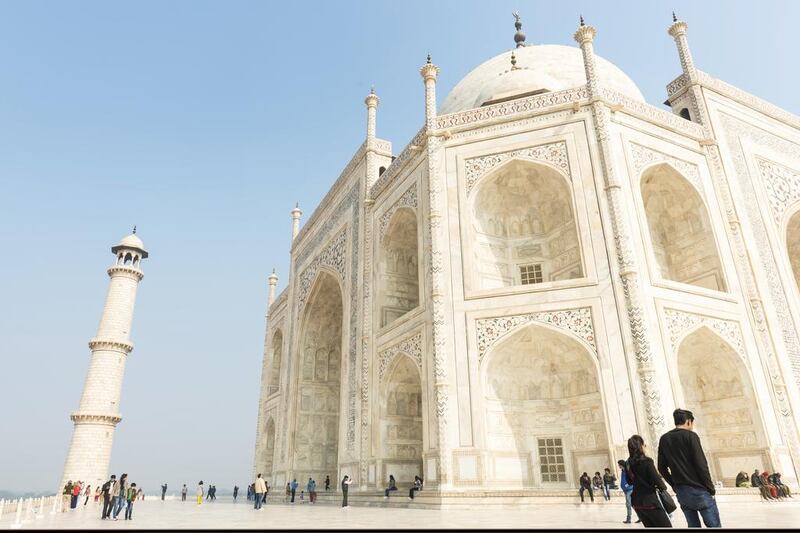India. Eight million square kilometres, packed with more than 1.2 billion people. The ever-mushrooming driving force of the subcontinent houses more human beings than North, Central and South America combined. In a Middle Eastern context, there are 132 people in India for every one in the UAE.
While India’s major cities are between three and five hours’ flight from the Emirates, when faced with such a wealth of conurbations and culture, it can be difficult to know precisely where to start. An organised tour group is how I come to be standing in the dazzling sunshine of semi-arid rural Rajasthan, covered in powdered and water-soluble paint, dyed every shade of the colour wheel. I haven’t picked just any week to explore India’s so-called Golden Triangle (New Delhi, Agra, Jaipur). This is the festival of Holi. During Holi, you don’t “celebrate” – you “play”. And “play” gets awfully messy.
Five days earlier, arriving in New Delhi, the scene could scarcely have been more different. Our transfer car is lashed by persistent rain as it scoots into the darkness en route to my base for the next two nights: the Sarovar Portico hotel, in the shadow of the Delhi Metro, in the vaguely obscure district of Naraina.
The first of the eight days of this Holi-themed “Taj Express” tour, which is run by the British-based company On the Go Tours, is merely a travel day. The real tourism doesn’t start until day 2, after an 8.30am meeting to introduce our tour leader, Vansh, and the rest of our 12-person group (comprising Brits, Australians and Americans between the ages of 21 and 35). Vansh will later become the most enthusiastic “player” in our Holi games, armed with a hose pipe and fistfuls of powdered paint; for now, he’s a reassuringly streetwise and gregarious host.
India’s vast scale means that even comparative religious minorities wield huge numbers in this predominantly Hindu country. Islam is followed by about 15 per cent of the population, but scaled up, that’s getting on for 180 million Muslims. Globally, only Indonesia and Pakistan have larger Muslim populations.
We’re introduced to plenty of Islamic sites in the opening half of the tour, including our first port of call in Old Delhi, preceded by a five-minute rickshaw ride through narrow backstreets. The Jama Masjid is India’s largest mosque, a 17th-century goliath conceived by the Mughal emperor Shah Jahan, the man best known for the Taj Mahal. On a damp Delhi morning, its minarets and off-cream domes rise high into overcast skies. Pradeep, an additional guide travelling with us for the day, notes that the mosque can hold as many as 25,000 worshippers.
One of the most humblingly peaceful sites in Delhi awaits next. The Raj Ghat, set within tranquil gardens, is the site of Mahatma Gandhi’s cremation. There’s a palpable aura about the place, which centres round a black marble slab marked with an “eternal” flame and swathed in flowers.
It’s then back into New Delhi, zipping through the diplomatic quarter, past the Indian parliament buildings and the Rajpath that leads to India Gate’s stately arch. As our bus driver picks his way through Delhi’s disorderly (yet somehow orderly) traffic, the city’s governor whizzes by in a white Mercedes, sharply at odds with the plethora of kei cars and autos (the Indian version of tuk-tuks) that flood the streets.
The day also takes in three stunning Unesco World Heritage Sites, all with Islamic importance: Humayun’s Tomb, the Qutub Minar and the Red Fort, respectively the burial place of the 16th-century Mughal emperor Humayun; the second-tallest minaret in the country; and a sprawling red-sandstone Shah Jahan construction. The first day is whistle-stop, but it would take twice the time to see all of these sites under your own steam.
Another benefit of taking a group tour in India is that less confident travellers can largely negate the pervasive (and persuasive) tipping culture. There’s a set “tip kitty” that you pay into on the first morning, which is then redistributed by Vansh at appropriate junctures. In a country where seemingly everybody is selling something and/or has their hand out, it’s a welcome respite.
The unseasonably dull Delhi weather hasn’t lifted by the time we depart on day 3, into Uttar Pradesh, towards Agra. Today is really about one thing for the dozen-strong tour group: seeing the Taj Mahal. As an over-cynical traveller, I’m fairly ambivalent beforehand – in a world where images of every iconic building in the world are beamed into your peepers via multiple media, the phenomenon of “monument fatigue” has hit me more than once on first views. The Colosseum? Yep, looks like I imagined. The Eiffel Tower? Meh.
My cynicism evaporates the closer we get to the Taj Mahal, however. First, it’s visible in the distance from Agra Fort, the Unesco-feted, Mughal-built prelude to our afternoon Taj tour. Once the detail of the famous building comes into focus, it’s impossible to be blasé any longer, particularly the Quran passages inscribed in Arabic around the building’s soaring entrance arches. Inside, two tombs represent the final resting places of Shan Jahan and his wife Mumtaz, the muse for the Taj Mahal, and are the only elements of the site that aren’t built in perfect symmetry.
We stay at the Utkarsh Vilas, back in the centre of Agra, a grubby city barely befitting such a grandiose monument. Vansh advises us that it’s not safe for us to venture out alone, which is a flip-side of the sanctuary of a group tour – there aren’t many safer ways to see India, but you occasionally feel mollycoddled and unable to fully experience the culture, food and people.
On day 4, we hit the highway again, heading into Rajasthan and the “Pink City” of Jaipur, via another Unesco-approved Islamic site of note, Fatehpur Sikri. The capital of the Mughal Empire in the late 16th century, it was subsequently abandoned because of lack of water. More than four centuries later, most of the city is in ruins, aside from its regal imperial complex. Its red-sandstone architecture is carved into complex motifs, but, sadly, the upper floors are closed to the public, so we experience it only from ground level.
In Jaipur, we enjoy a stimulating display of fabric block-printing at Jaipur Handicrafts, where I splash out on a tailored shirt and we’re handed plain-white cotton “pyjamas” in preparation for Holi (the latter included in the tour price). At dusk, we check in for the first of two nights in the hippest accommodation of the tour, the glowing-green-themed Peppermint Hotel, on the city’s outskirts.
Our first look at the terracotta-coloured facades of Jaipur’s old city arrives on the morning of day 5, en route to the hillside Amber Fort. The tour offers an optional hot-air-balloon flight at dawn over the Amber Fort, but it’s an additional 17,000 rupees (Dh997) and involves two hours less in bed, so I politely decline. I settle instead for an elephant-back ride up to the fort. It’s perhaps the most touristy site of the week – we chuckle at rotund tourists nigh on giving the elephants hernias, but we’re not laughing when every corridor and courtyard is so chock-full with visitors that it’s hard to appreciate the architecture.
Back in Jaipur itself, I don’t take much convincing by two fellow tour-group members to skip a staid demonstration of gem inlaying in favour of escaping to a street eatery called Ram Restaurant for hearty, cheap thalis. After lunch, we visit the City Palace and another Unesco site, the Jantar Mantar, a fascinating display of architectural astronomy instruments built by the innovative Rajput king Sawai Jai Singh.
Early evening is spent purchasing supplies for the following day’s Holi “play”, including water pistols from street-market stalls. Back at the Peppermint Hotel, henna painting has been arranged for the group at its rooftop lounge bar. From there, we watch as Holi pyres across the city’s streets are set alight, illuminating the landscape as the sun sets.
Day 6 is the big event: Holi. Our drive to the village of Alsisar is punctuated by drive-by water-pistol attacks on unsuspecting Indians and a cloud of powdered dyes being smeared on one another inside the bus. We’re welcomed at the Indra Vilas by music, drinks and a table piled with multicoloured paint. Things get rowdy for the next couple of hours, with the heritage hotel’s lawn and swimming pool turning into a bright battlefield of good-natured Holi antics.
The next morning, we explore the village’s painted havelis and humble surrounds, trailed by two cheeky children demanding sweets and small change, before jumping back in the bus for the eight-hour-plus haul to Delhi, and another night in the Sarovar Portico (day 8 is a free/travel day).
The journey may be over, but we’ll be washing a veritable Dulux chart of paint off our hair, ears and skin for a week or more, a colourful reminder of India’s rough-edged charms, even when experiencing it on a scheduled tour.
aworkman@thenational.ae
Follow us @TravelNational
Follow us on Facebook for discussions, entertainment, reviews, wellness and news.





